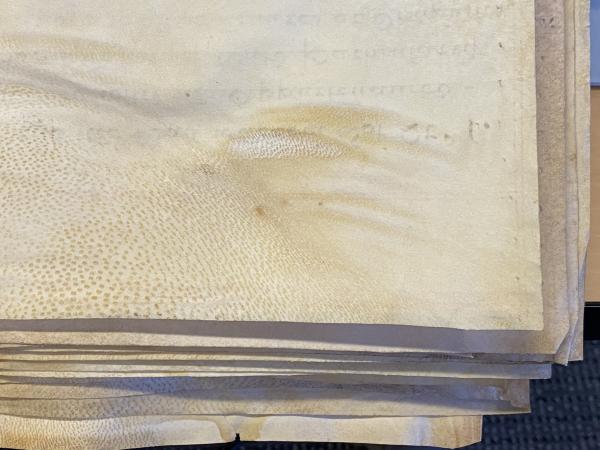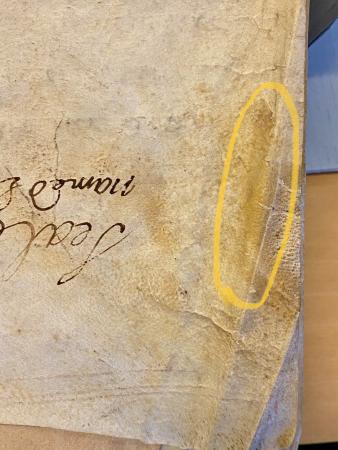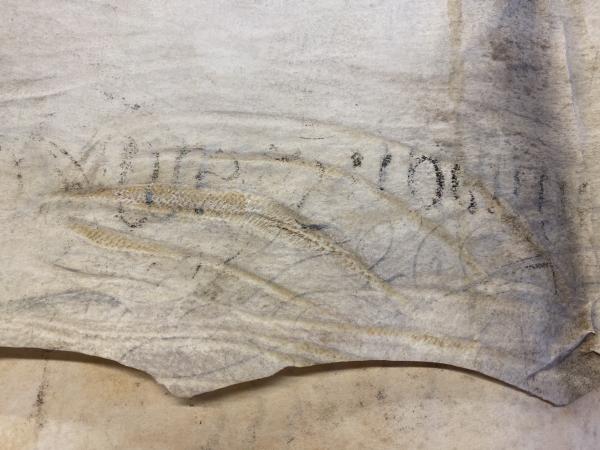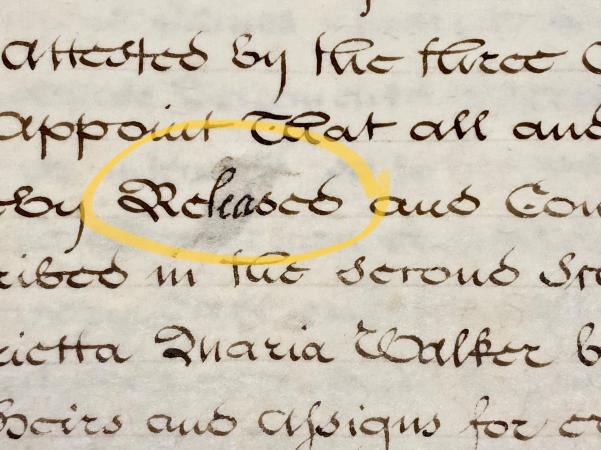As you’ve likely seen on our social media and blog, back in the spring, we received the Hungerford Deed via a generous donation. It has proven to be a fount of fascinating information about the family of James Smithson, our founding donor (read: family drama worthy of your favorite British period piece!), as well as a source of endless material culture interest—down to the very materials that were used to fabricate the document. Almost immediately upon seeing the deed (first in photographs, then in person), I felt reasonably certain that it was written on parchment. But there are more clues to its identification than just a brief or initial look.

What is parchment and how is it made?
Parchment is made from chemically treated animal skins, much like leather. Besides the differences in the chemicals used to treat the hides, after cleaning them of hair and tissue, parchment is stretched onto a frame and dried under tension. This process imparts particular properties to parchment, including a stiff or rigid quality to handling it, a smooth surface (partly from collagen released from the skins during parchmenting, partly from smoothing treatments such as rubbing the skin with pumice), and optical brightness. Parchment is also quite strong and durable, though susceptible to biological attacks. It is extremely sensitive to moisture, expanding and contracting with changes in the relative humidity, and may become hard and transparent (or “gelatinize”) when wetted.

How do you identify parchment?
Some aspects of identifying parchment (such as the handling characteristics described above) can be assessed by the experienced eye, sometimes referred to in cultural heritage as connoisseurship—because an individual has experience with parchment, it is that much easier to recognize parchment when faced with a new artifact. In handling the deed, I could feel that it was rigid and stiff and had the surface texture and heft I would expect from parchment. In addition, I knew that legal documents were recorded on parchment for centuries.

There are also many visual clues to parchment’s identity that are visible to the naked eye, or with magnification. Our deed shows the animal origins of the material incredibly clearly, with several of the sheets showing strong hair follicle patterns and irregular edges that may reflect the outer perimeters of the animal’s skin. Evidence of the cleaning process used to create the parchment is also clearly visible; the natural variations in the thickness of the skin resulted in portions being inconsistently scraped. Evidence of wear and deterioration also help confirm that the deed was written on parchment. Areas where water damage occurred have become gelatinized, as described above, and consequently brittle. You can also see where scribes made corrections: when a mistake was made, the surface of the skin was scraped away, removing the ink as well, and then replaced by new writing.

This evidence was more than sufficient for us to confidently identify the material as parchment. There are, however, additional tests that can be done in cases where it is more difficult to determine. These are mostly destructive tests, relying on examination of cross-sectioned samples via microscopy, or the flame test, in which a sample is burned to see if it gives off the distinctive scent of burning animal protein. Other techniques such as Fourier-Transform Infrared Spectroscopy (FTIR), which identifies chemical bonds in a given sample of organic material, can be used to identify proteins in parchment, as opposed to starches in paper.
What happens now that we know it’s parchment?
Knowing that the deed is written on parchment impacts how we choose to treat and store it. As I described in my previous post about the deed, I chose to very gently and slowly humidify the parchment sheets because of how sensitive parchment is to moisture. Too much moisture would be damaging to the document and can result in gelatinization as the photos show. Keeping the deed under tension or weight while drying is also key, given the tendency of parchment to distort. This will be especially important as we undertake the next step in treatment, to mend some of the damage lying along the gelatinized folds of the outer parchment sheet.
We also keep the deed in as stable of an environment as we can within our collections storage space. Fluctuations in temperature and relative humidity are problematic for any of our archival collections, but because parchment is especially sensitive, we will pay extremely close attention to its condition.
Related Resources
- AIC’s Book and Paper Group Wiki, Parchment
- “I.D. This! Solid Inkjet Print,” by Alison Reppert Gerber, The Bigger Picture, Smithsonian Institution Archives
Produced by the Smithsonian Institution Archives. For copyright questions, please see the Terms of Use.

Leave a Comment